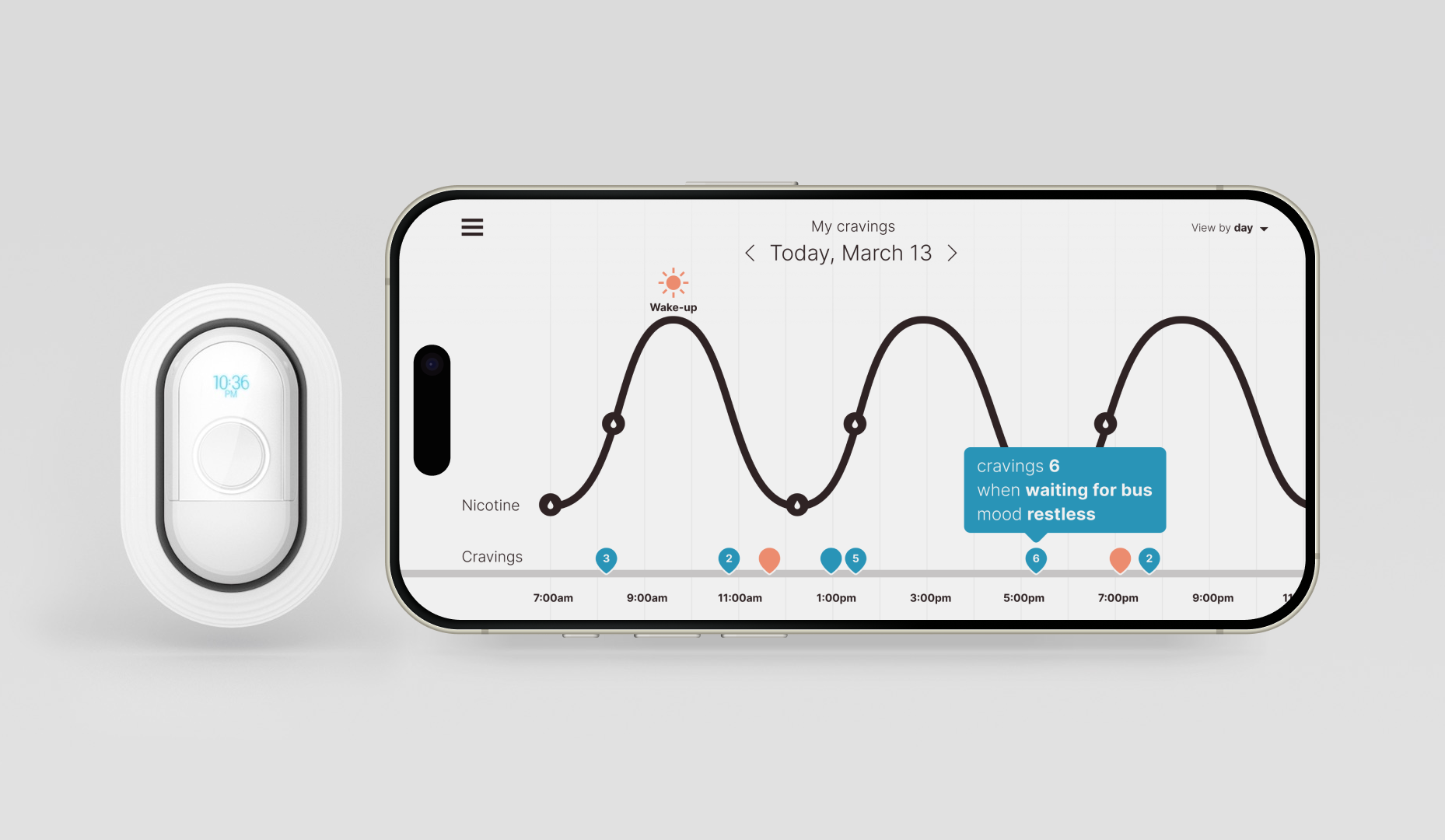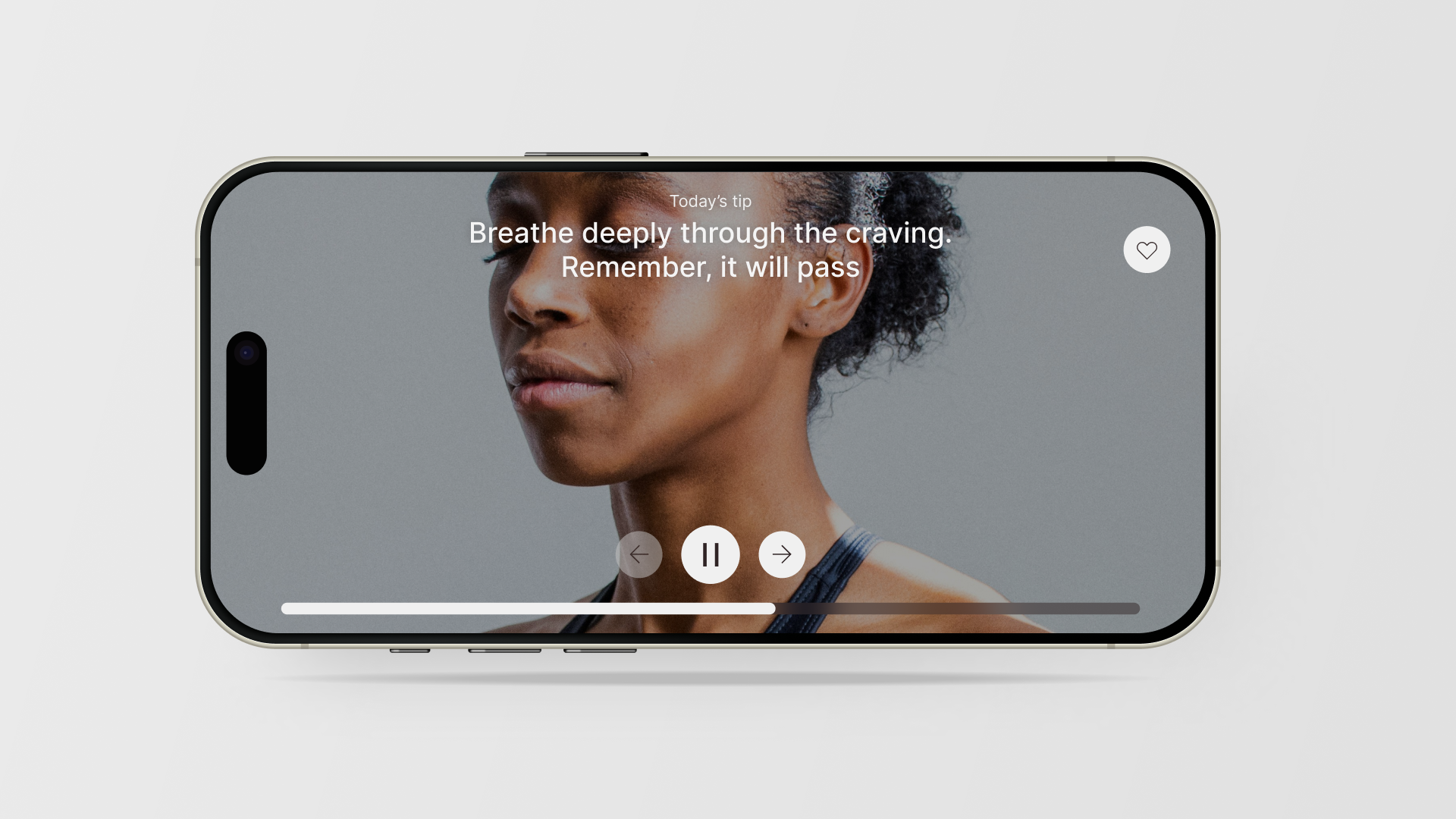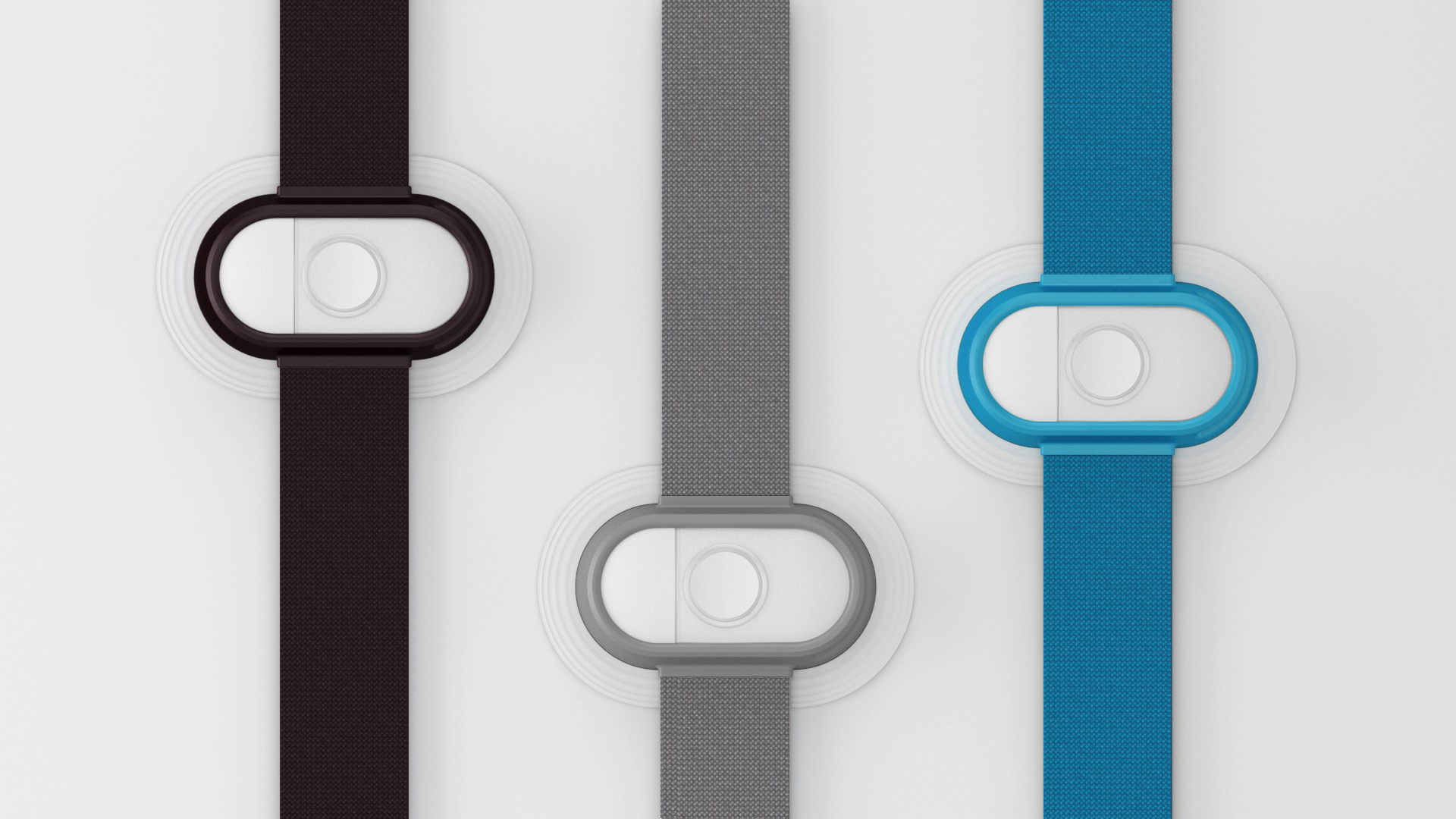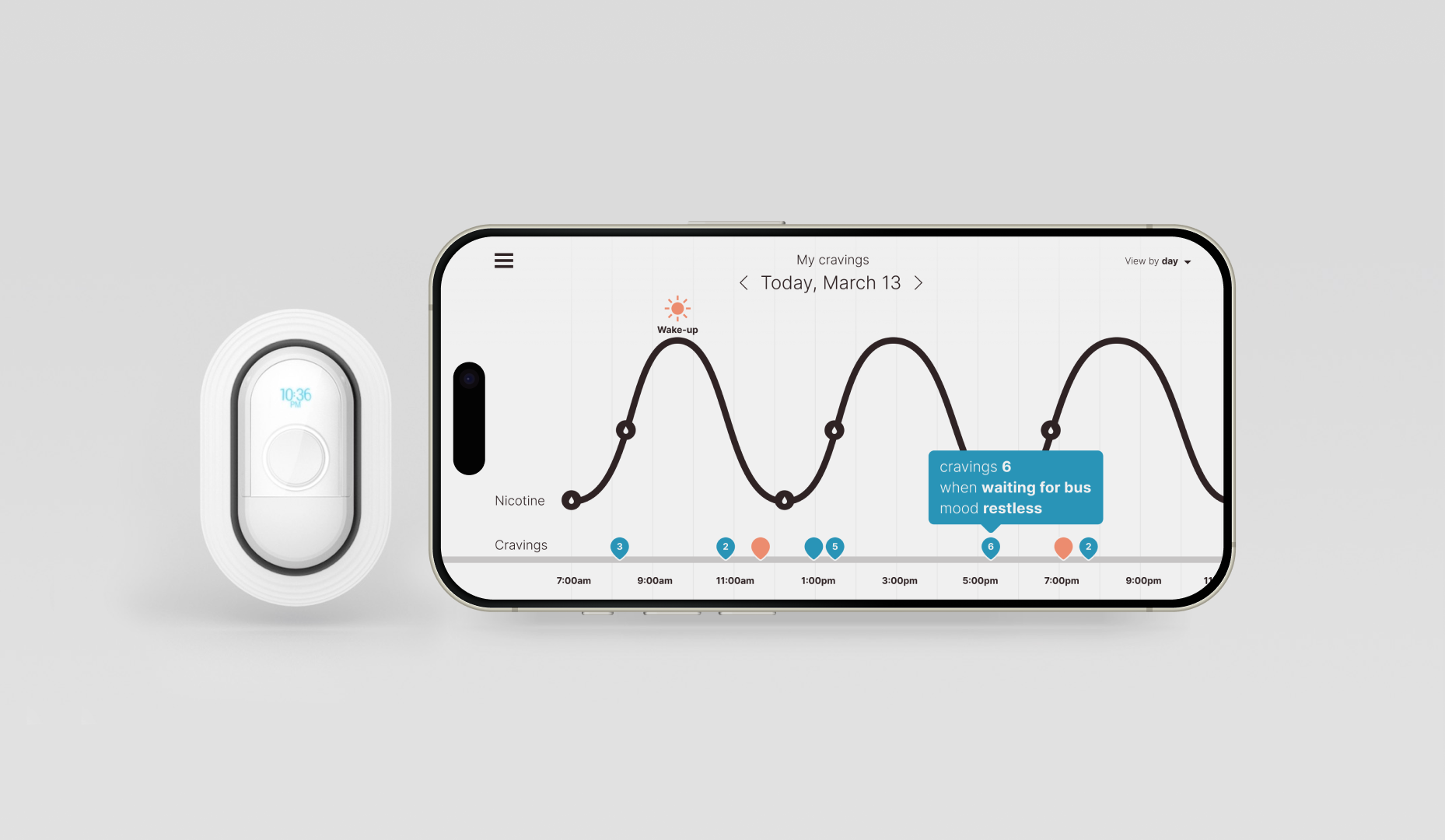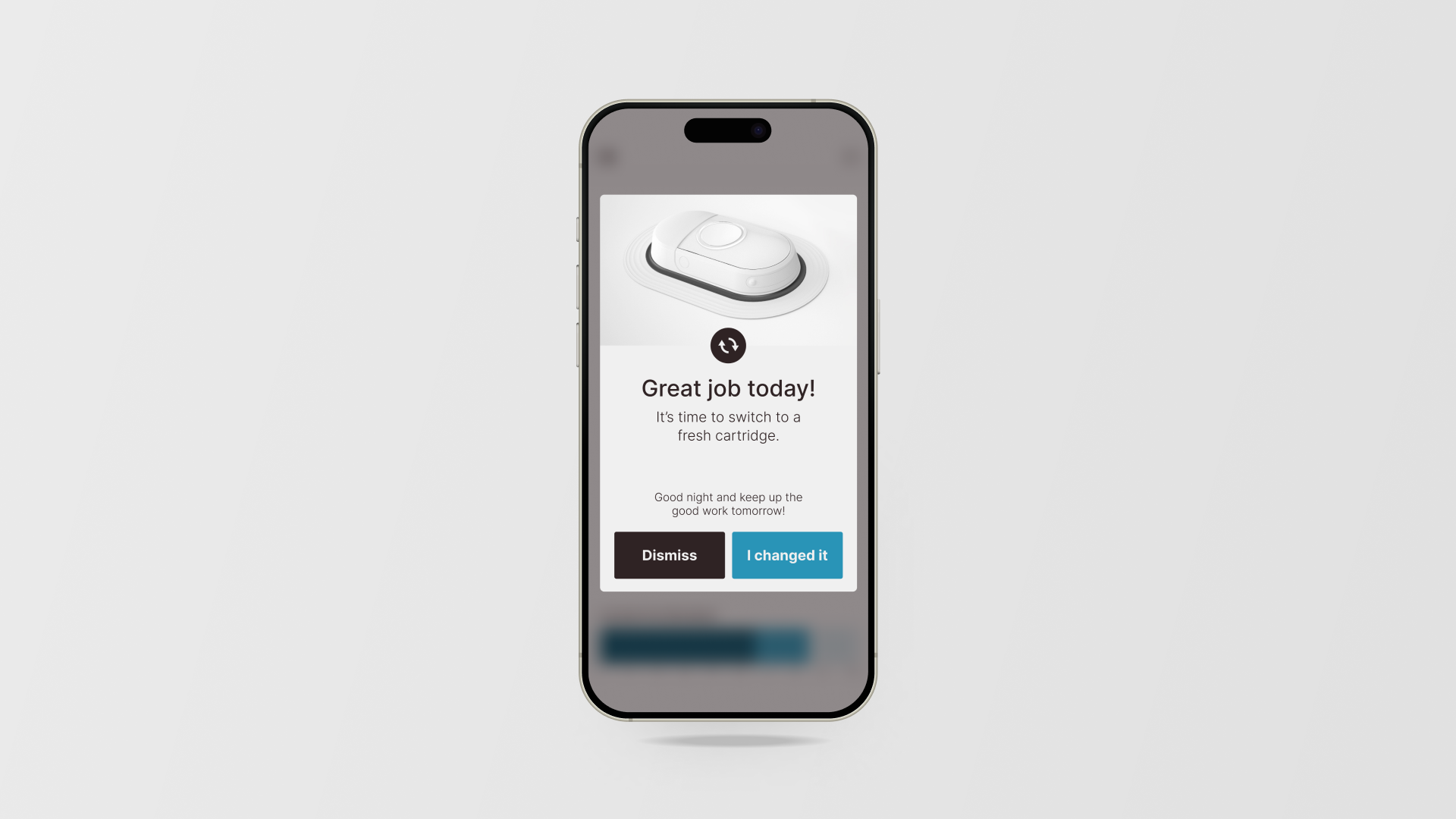
Overcoming addiction
Breaking complex dependencies to improve people’s wellbeing
The ask
How can design transform the way we eradicate addictions?
Problem
Smoking poses life-threatening risks, with 5 million people dying from it each year. Nicotine is as addictive as heroin, cocaine, or alcohol, and most smokers attempt to quit 8-10 times before succeeding. Despite this, traditional cessation programs have less than a 5% success rate.
Managing and overcoming addiction requires more than just medication or therapy. Innovative solutions are urgently needed to address both the physical and psychological aspects of nicotine dependence, as current treatments are not getting the job done.
Solution
Through clean, purposeful design and a focus on enhancing health and wellness, Chrono transforms the quitting journey into an empowering and meaningful experience.
By seamlessly integrating a medication delivery wearable with personalized behavioral support, Chrono addresses the physical, behavioral, and psychological aspects of addiction. Its elegant approach not only helps users overcome nicotine dependency but also redefines quitting as a journey of self-care and personal growth.
As the first solution of its kind, Chrono aims to reduce the stigma around addiction, making the path to recovery as beautiful and commendable as it is effective.

“Chrono synthesizes the complexities of addiction to offer a personal, centralized solution that works in real-time.”
— Jennifer Darmour
Three Recovery Hurdles. One Solution.
Physical
Nicotine affects the brain's reward system by stimulating the release of dopamine. According to the Centers for Disease Control and Prevention (CDC), about 80% of smokers who attempt to quit on their own relapse due to the physical withdrawal symptoms within the first two weeks.
Around 60% of people experience longer-term symptoms when they quit. Studies show that cravings peak in the first few days and subside after about 2-3 weeks. However, nicotine withdrawal symptoms may last for weeks or months, contributing to relapse.
Psychological
Smoking is often a way for people to cope with stress, anxiety, or other emotional challenges, including anxiety and depression.
A study by the American Psychological Association found that around 30% of smokers trying to quit experience depression or depressive symptoms. Depression and anxiety can be exacerbated by the absence of nicotine, which temporarily improves mood by increasing dopamine levels.
This makes it harder for smokers to break addiction. Quitting smoking is often an emotionally taxing process, and individuals with emotional support—tend to handle the stress and cravings better.
Behavorial
Smoking is often a deeply ingrained habit tied to specific behaviors and routines. 95% of smokers associate specific triggers with their smoking habit, and these conditioned triggers are one of the main causes of relapse.
Breaking the behavioral component of smoking requires changing routines and habits, such as finding alternatives like chewing gum or exercising.
A precise and personalized way to administer drugs
Chrono offers a revolutionary nicotine replacement solution that addresses the shortcomings of traditional patches. Unlike standard patches, which lose effectiveness by the end of the day, Chrono’s smart patch delivers precisely timed nicotine doses based on the user’s cravings and addiction strength.
It begins delivering nicotine before the user even wakes up, tackling the intense morning cravings most smokers experience. The device continuously adjusts dosage throughout the day, helping users gradually reduce their dependency.
It also features a manual boost button, allowing users to self-administer extra support, a feature inspired by smokers' real-life behaviors.
Chrono is paired with an app that makes the journey to quit smoking more manageable, personalized, and focused on wellbeing, making it a holistic tool for smoking cessation.
Rigorous attention to users needs and behavior
Chrono underwent extensive user testing, including focus groups and interviews, to better understand the challenges and behaviors associated with smoking cessation.
During multiple prototyping iterations, feedback was closely analyzed to ensure the design met user needs. One example is when cravings hit, users unconsciously rubbed their nicotine patch, instinctively seeking a boost.
As a result, Chrono’s design was refined to include a self-administering button on the pod, helping users curb cravings when they arise. The result is a seamless and satisfying user experience, with a clean, purposeful design that supports users in overcoming addiction for life.
Stay motivated and in control every step of the way
Research published in the journal Addiction found that smokers who receive both professional and social support are 50-100% more likely to remain smoke-free compared to those who attempt to quit without support.
Embedded with sensors and Bluetooth, Chrono’s wearable pod monitors the user’s medication intake and securely transmits data to the program's digital coaching app.
Chrono offers proactive reminders and personalized encouragement, including motivational messages to reinforce users' reasons for quitting when challenges arise. The app helps users stay on track by providing real-time progress updates.
With its seamless integration of technology and personalized support, Chrono keeps users engaged and accountable throughout their smoking cessation process, significantly enhancing the chances of long-term success.
Features
Managed.
Chrono delivers nicotine precisely when cravings peak to combat early withdrawal symptoms. This proactive approach helps users to stay focused on their recovery journey without physical distraction.
Monitored.
Chrono’s pod, embedded with sensors and Bluetooth, monitors medication usage and securely transmits data to the coaching app — sharing progress and proactively reminding users to stay on track.
Supported.
Based on real-time data, the coaching app reaches out during critical moments and provides evidence-based strategies to help users manage cravings and maintain their commitment to quitting.
Stylish.
Discreet and stylish design available in various colors and styles, Chrono is designed for everyday wear, appealing to a broad range of users
The complexities of developing a highly regulated product
Bringing Chrono to market presented significant challenges, requiring FDA approval across three regulated categories, alongside complex industrial design and engineering demands. These factors added layers of testing and regulatory hurdles, making the process especially difficult as the first product of its kind.
FDA Approvals
Chrono required FDA approval across three categories and navigating approvals for each component independently was one of the most significant hurdles in the development process.
New Drug — As a new nicotine replacement therapy (NRT), the medication had to prove its efficacy in helping smokers quit.
Medication Delivery Device — The wearable pod, responsible for administering the drug, had to meet stringent safety and dosage consistency standards.
Mobile App — Since the app communicates with the device and tracks user data, it also had to pass FDA approval as a medical device software.
Design & Function
Designing a wearable that is functional, intuitive, and comfortable posed several design, engineering, and production considerations.
Size and Form Factor — The device had to be compact enough for everyday wear while still accommodating the drug delivery system. Elements like the battery made keeping the wearable small challenging.
Mechanical, Not Electrical — To minimize errors and ensure reliability, the internal mechanics relied on springs rather than electronics, adding bulk and complexity to the design.
Water Resistant — The device needed to be water-resistant, requiring additional engineering without sacrificing usability or comfort.
Breathable Material — Chrono’s band needed to be made of comfortable, breathable material, accounting for a variety of lifestyles, and to allow 24/7 wearability.
Clinical Trials
A five-week clinical trial, backed by a substantial multi-million dollar investment, faced a critical setback when a single participant compromised the results. This failure led to the FDA denying approval, halting progress, and impacting the ability to bring the product to market.
The incident highlighted the risks inherent in clinical trials, particularly the influence of human factors, and emphasized the need for more stringent trial design and participant vetting.
Despite the challenges, Chrono attracted interest from major industry partners, highlighting its market potential and the critical need for FDA approval to unlock these opportunities.
